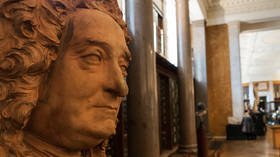The removal of a bust of the British Museum’s founder is no trivial issue. It is a step towards the erasure of the Enlightenment

The wrong-headed decision to give the activists a victory by ‘toppling’ Hans Sloane will not end their campaign, but boost it. These people will not stop until they have destroyed the very principles of Western society.
The British Museum has moved the bust of its founder from its prominent position. Hartwig Fischer, the museum’s director, this week announced that due to social media pressure from Black Lives Matter, the sculpture of Sir Hans Sloane had been moved to a cabinet, where it is surrounded by contextualising material. Activists state that Sloane benefitted from owning slaves. Fischer took up the iconoclastic imagery of social-justice rioters by stating, “We have pushed him off the pedestal, we must not hide anything.”
Sir Hans Sloane was a leading physician in London. He saved countless lives from the 1680s onwards through pioneering smallpox vaccination and malaria treatment. He travelled widely and sought to understand the natural world and human culture, which led to him form a large collection of historical and man-made artefacts.
He believed that material should benefit humanity, so, upon his death in 1753, he bequeathed it to the British nation. It was an act of philanthropic generosity which led to the foundation of the British Museum, British Library and Natural History Museum (originally in one body) in 1753.
In his commitment to medicine and science, Sloane (1660-1753) was a man of the Enlightenment. When he lived in Jamaica, Sloane married a plantation heiress. Her family owned slaves but it is unclear if Sloane himself “owned slaves,” as the British Museum puts it. (He is labelled “collector and slave-owner” in the new display.) Whether or not he owned slaves, he benefited from the money generated by a plantation which used slaves. This is not news and has been common knowledge for hundreds of years, freely discussed in many books.
The moving of Sloane’s bust is not enough for the activists, who want more. The museum is now reviewing its Sloane manuscripts. Activists are targeting the names of Sloane Street and Sloane Square in London, among other roads named after him, and a statue of him in Chelsea. Appeasement simply receives no gratitude, only continual and escalating demands for further concessions.
Contextualisation is humiliation
Fischer and his colleagues understand that contextualisation of Sloane’s bust allows curators to gain the petty satisfaction of belittling a great man. Fischer, the British Museum’s first German director, has shown himself to be willing to work against the Enlightenment ethos of the museum before. Back in June, Fischer announced that “The British Museum stands in solidarity with the Black community throughout the world. Black Lives Matter.” Why Fischer – or the British Museum – should be pledging support for an American radical Marxist organisation was not explained.
Fischer continued that the British Museum would “reconsider, rethink and rebalance the display of the collection, introducing greater diversity of collections on display, expanding museum narratives. And above all, involving multiple voices.”
“Multiple voices” is a euphemism for the common practice of activist curators consulting lobbying groups which share political aims. These groups provide (politically agreeable) consultation reports that curators then use to justify distortion of historical record, removal of artefacts from view and introduction of pejorative contextualisation.
Fischer is following the leftward drift of curation. The UK’s Museums Association now promotes curators who admit their agendas are to dismantle established critical standards.
Also on rt.com Overdue antidote to Black Lives Matter’s poisonous ideology arrives in the form of Britain’s ‘strictest teacher’Demolishing Enlightenment Values
The British Museum was founded as a part of the Enlightenment project to gather and disseminate knowledge of world cultures for the benefit of all. That is why the British Museum is free to visitors and visited daily by people from around the word who wish to see the best of their culture surrounded by artefacts from other cultures.
Sloane’s thinking has resulted in generations of ordinary people seeing world culture firsthand. Sloane may be more responsible for the spread of appreciation of world culture than any other Briton; his health work saved huge numbers of lives. While they are correct in denouncing slavery, activists who denigrate Sloane’s memory have not benefitted humanity, merely stoked discontent and exploited division.
There are a number of reasons why BLM and race activists – primed by anti-patriotic educators in the UK and US – attack the basis of the British Museum. They hate anything that reflects British imperialism. They advance themselves through the victim narrative. They oppose the ideas that underpin the Enlightenment – the scientific principle, study of objective knowledge and the extension of the franchise to reduce injustice.
They claim the Enlightenment is so riven by colonialism and “systemic racism” that it must be opposed, diminished and – ultimately – erased in the name of social justice. The new pseudo-science of critical race theory will replace science and be used for political indoctrination.
Sloane’s bust is not a trivial issue. It demonstrates the tightening grip of dogmatists and grifters who despise not just institutions such as the British Museum but the principles of Western society.
Fischer cannot be trusted to head a national museum. His repeated capitulation to fringe anti-British activists show that he is complacent towards – or complicit in – undermining the British Museum, one of the great gems of Enlightenment culture.
Like this story? Share it with a friend!
The statements, views and opinions expressed in this column are solely those of the author and do not necessarily represent those of RT.















